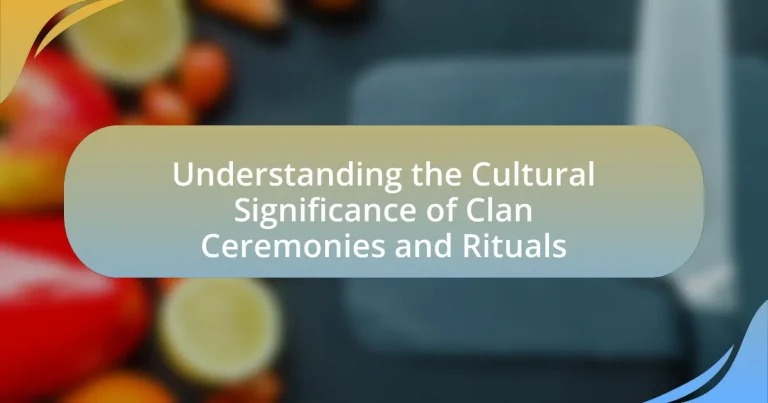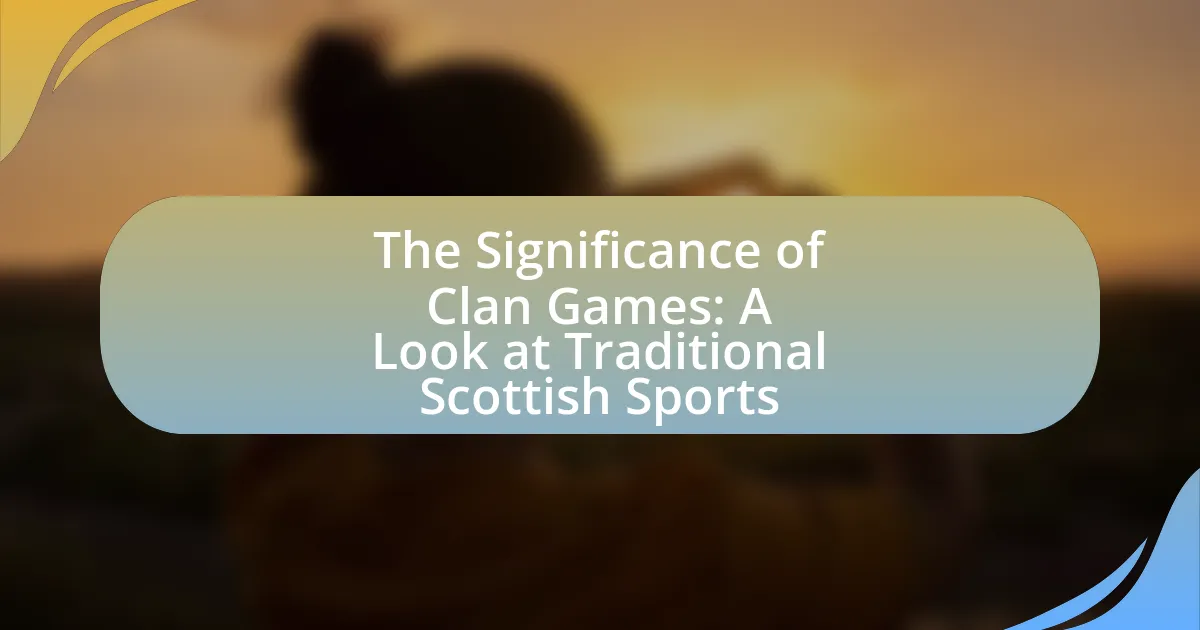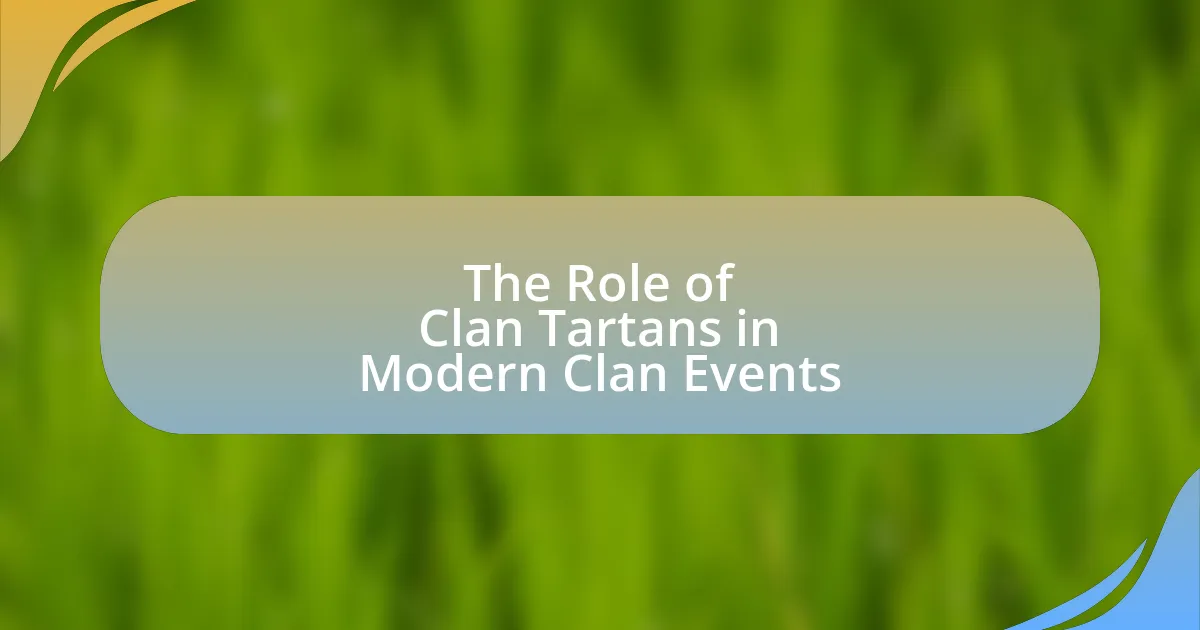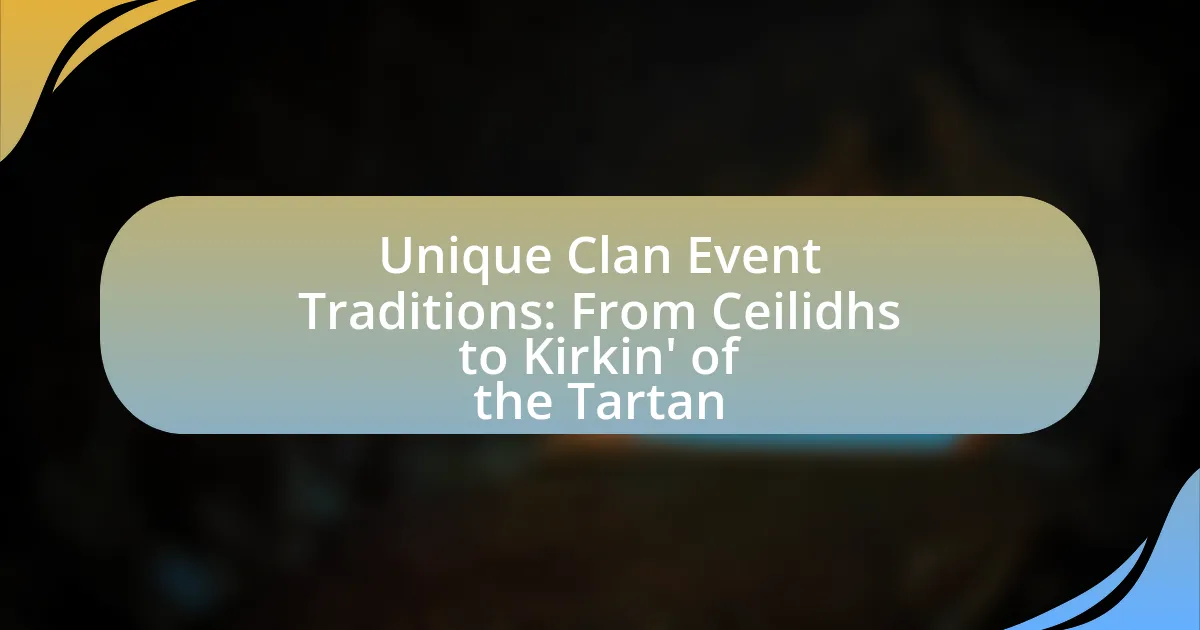Clan ceremonies and rituals are structured cultural events that play a crucial role in reinforcing social bonds, traditions, and identity among clan members. These ceremonies, which include rites of passage and communal gatherings, vary across cultures and serve to preserve heritage and values. Common elements such as communal participation, symbolic acts, and the invocation of ancestral spirits enhance their significance, while historical contexts influence their themes and practices. The article explores the importance of these rituals in fostering community cohesion, identity formation, and emotional well-being, as well as the challenges they face in contemporary society and the modern adaptations that have emerged. Additionally, it highlights resources and organizations dedicated to the preservation of these cultural practices.
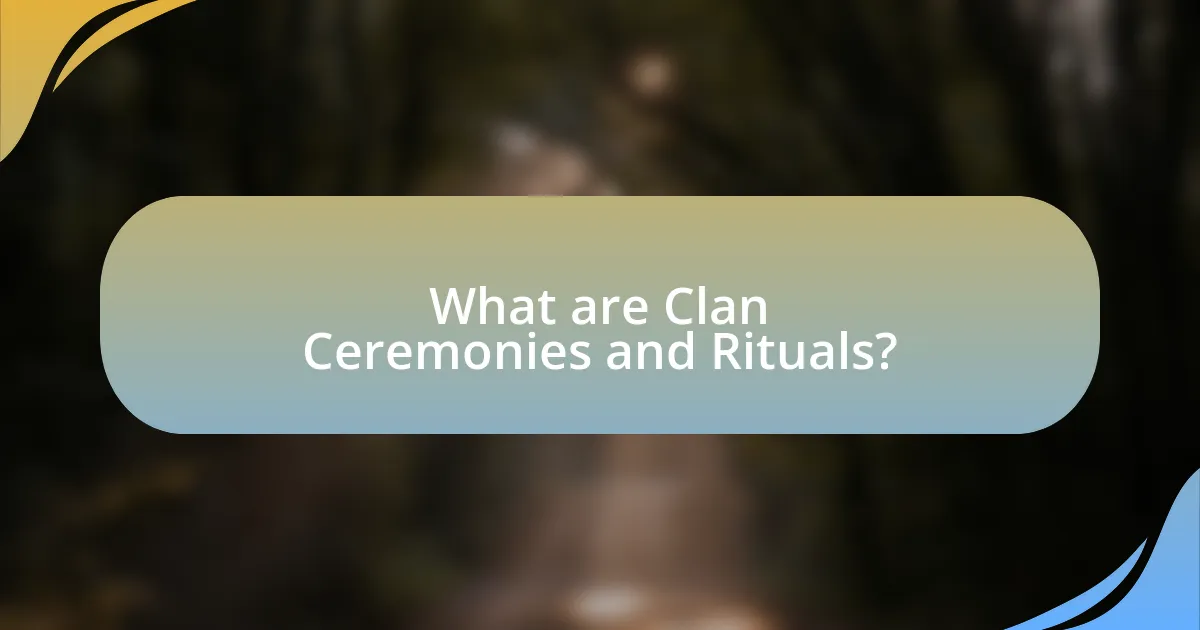
What are Clan Ceremonies and Rituals?
Clan ceremonies and rituals are structured events that hold significant cultural meaning for members of a clan, often serving to reinforce social bonds, traditions, and identity. These ceremonies can include rites of passage, seasonal celebrations, and communal gatherings, which are integral to maintaining the clan’s heritage and values. For example, many Indigenous cultures conduct ceremonies to mark important life events such as births, marriages, and deaths, which are essential for the continuity of cultural practices and beliefs. The importance of these rituals is underscored by their role in fostering a sense of belonging and community among clan members, as well as preserving historical narratives and cultural knowledge across generations.
How do Clan Ceremonies and Rituals vary across cultures?
Clan ceremonies and rituals vary significantly across cultures in their practices, meanings, and purposes. For instance, in many Indigenous cultures, clan ceremonies often emphasize connection to the land and ancestors, such as the Native American powwow, which serves to celebrate heritage and community. In contrast, in some African cultures, rituals like the Maasai’s Eunoto ceremony mark the transition of warriors to elder status, highlighting social hierarchy and communal identity. Furthermore, in East Asian cultures, clan rituals may focus on ancestor worship, as seen in the Chinese Qingming Festival, where families honor their ancestors through grave sweeping and offerings. These variations illustrate how cultural context shapes the significance and execution of clan ceremonies and rituals, reflecting diverse values, beliefs, and social structures.
What are the common elements found in Clan Ceremonies and Rituals?
Common elements found in clan ceremonies and rituals include communal participation, symbolic acts, and the invocation of ancestral spirits. Communal participation fosters unity among clan members, reinforcing social bonds and shared identity. Symbolic acts, such as dances, offerings, or totems, convey cultural values and beliefs, often reflecting the clan’s history and traditions. The invocation of ancestral spirits serves to honor lineage and seek guidance, emphasizing the connection between the living and their forebears. These elements collectively enhance the cultural significance of clan ceremonies and rituals, ensuring the transmission of heritage and communal values across generations.
How do historical contexts influence Clan Ceremonies and Rituals?
Historical contexts significantly influence Clan Ceremonies and Rituals by shaping their themes, practices, and meanings. For instance, historical events such as colonization, migration, or conflict often lead clans to adapt their ceremonies to reflect resilience or cultural preservation. An example is the impact of colonialism on Indigenous ceremonies, where traditional practices were modified to incorporate elements of resistance against oppression, thereby reinforcing cultural identity. Additionally, historical alliances or rivalries between clans can dictate the nature of rituals, as seen in ceremonies that commemorate peace treaties or historical battles, which serve to strengthen communal bonds or acknowledge past grievances.
Why are Clan Ceremonies and Rituals important to communities?
Clan ceremonies and rituals are important to communities because they foster social cohesion and reinforce cultural identity. These events serve as a means for members to connect with their heritage, share collective values, and strengthen bonds among individuals. For instance, anthropological studies show that rituals often mark significant life events, such as births, marriages, and deaths, which help to create a shared sense of purpose and belonging within the community. Additionally, clan ceremonies can facilitate the transmission of traditions and knowledge across generations, ensuring the continuity of cultural practices.
What roles do Clan Ceremonies and Rituals play in identity formation?
Clan ceremonies and rituals play a crucial role in identity formation by reinforcing social bonds and cultural heritage among members. These practices serve as a means of transmitting values, beliefs, and traditions, which are essential for maintaining a collective identity. For instance, ceremonies often mark significant life events, such as births, marriages, and deaths, thereby creating a shared narrative that strengthens group cohesion. Additionally, rituals can establish a sense of belonging and continuity, as they connect individuals to their ancestors and cultural history, fostering a deeper understanding of one’s place within the clan. This connection is evidenced by anthropological studies that highlight how such practices contribute to the preservation of cultural identity across generations.
How do Clan Ceremonies and Rituals foster social cohesion?
Clan ceremonies and rituals foster social cohesion by creating shared experiences that strengthen bonds among members. These events often involve collective participation in traditions, which reinforces a sense of belonging and identity within the clan. For instance, rituals such as initiation ceremonies or communal feasts serve to unite individuals through common values and beliefs, promoting mutual support and cooperation. Research indicates that such practices enhance trust and solidarity, as seen in studies on kinship ties and community engagement, demonstrating that clans with active ceremonial practices exhibit higher levels of social cohesion and resilience.
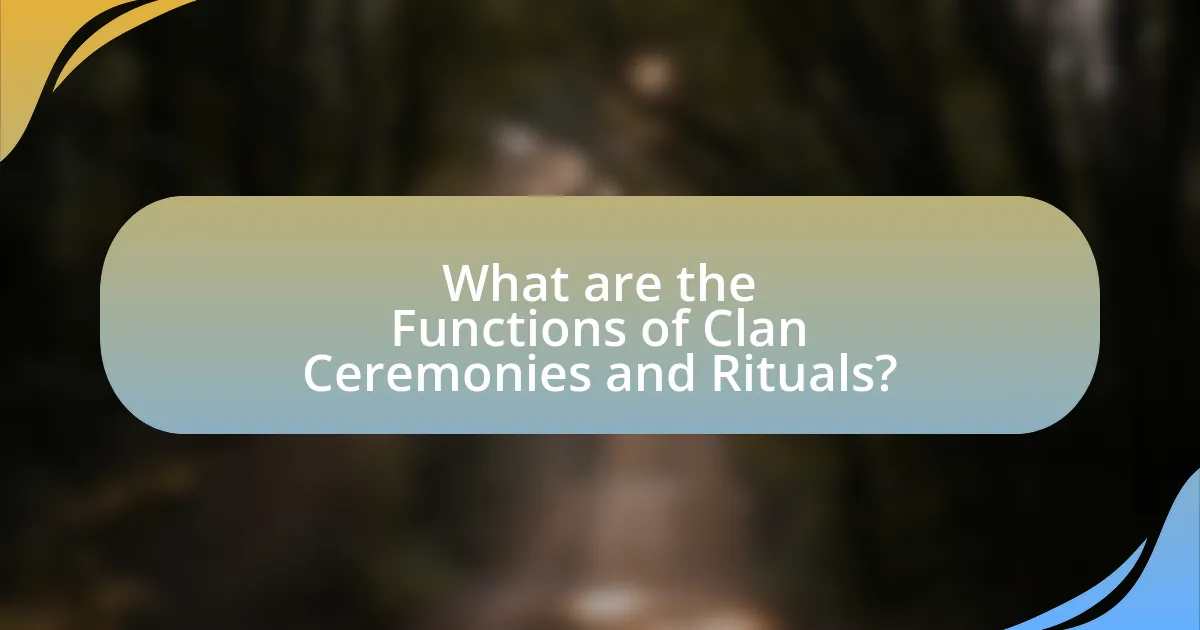
What are the Functions of Clan Ceremonies and Rituals?
Clan ceremonies and rituals serve multiple functions, including the reinforcement of social cohesion, the transmission of cultural values, and the marking of significant life events. These ceremonies create a sense of belonging among clan members, fostering unity and identity through shared traditions. For example, rituals often involve storytelling, music, and dance, which help to pass down historical narratives and moral teachings from one generation to the next. Additionally, clan ceremonies often commemorate milestones such as births, marriages, and deaths, providing a structured way for communities to celebrate or mourn collectively. This collective participation strengthens interpersonal bonds and ensures the continuity of cultural practices, as evidenced by anthropological studies that highlight the role of rituals in maintaining social order and cultural heritage within communities.
How do Clan Ceremonies and Rituals facilitate cultural transmission?
Clan ceremonies and rituals facilitate cultural transmission by serving as structured events that reinforce shared values, beliefs, and practices among members. These gatherings create a communal space where stories, traditions, and knowledge are actively shared and passed down through generations. For instance, rituals often involve storytelling that encapsulates historical events and moral lessons, ensuring that cultural narratives remain alive and relevant. Additionally, participation in these ceremonies fosters a sense of identity and belonging, which is crucial for maintaining cultural continuity. Research indicates that such practices are vital for the preservation of cultural heritage, as they engage individuals in a collective memory that shapes their worldview and social cohesion.
What stories or teachings are commonly shared during these events?
During clan ceremonies and rituals, stories and teachings that emphasize community values, ancestral heritage, and moral lessons are commonly shared. These narratives often include tales of ancestors who exemplified bravery, wisdom, or sacrifice, serving to reinforce the clan’s identity and cultural continuity. For instance, many Indigenous cultures recount creation stories that explain their origins and relationship with the land, which are integral to their cultural practices and beliefs. Additionally, teachings about respect for elders, the importance of unity, and the responsibilities of community members are frequently highlighted, ensuring that younger generations understand their roles within the clan.
How do Clan Ceremonies and Rituals reinforce values and beliefs?
Clan ceremonies and rituals reinforce values and beliefs by serving as structured expressions of cultural identity and communal solidarity. These events often involve traditional practices that embody the clan’s core principles, such as respect for ancestors, community cohesion, and the transmission of cultural knowledge. For instance, during initiation ceremonies, younger members learn about their heritage and responsibilities, thereby internalizing the clan’s values. Additionally, rituals like harvest festivals or marriage ceremonies often emphasize collective participation, which strengthens social bonds and reaffirms shared beliefs. Historical evidence shows that clans that actively engage in such ceremonies maintain stronger cultural continuity and social stability, as seen in various indigenous communities worldwide.
What are the emotional and psychological impacts of Clan Ceremonies and Rituals?
Clan ceremonies and rituals have significant emotional and psychological impacts, fostering a sense of belonging and identity among participants. These gatherings often reinforce social bonds, enhance community cohesion, and provide individuals with a shared purpose, which can lead to increased emotional well-being. Research indicates that participation in such rituals can reduce feelings of isolation and anxiety, as they create a supportive environment where individuals feel valued and connected to their heritage. For instance, a study by Bellah et al. (2008) highlights how communal rituals can enhance collective identity and promote psychological resilience, demonstrating the profound effects these ceremonies have on mental health and emotional stability.
How do participants experience connection and belonging during these events?
Participants experience connection and belonging during clan ceremonies and rituals through shared cultural practices and communal engagement. These events foster a sense of identity and unity as individuals come together to celebrate traditions, reinforcing social bonds and collective memory. Research indicates that participation in such rituals enhances feelings of belonging, as individuals engage in meaningful interactions and shared experiences, which are crucial for social cohesion. For example, a study by Bellah et al. (2008) highlights that communal rituals create a sense of solidarity among participants, emphasizing the importance of collective identity in fostering belonging.
What role do Clan Ceremonies and Rituals play in coping with loss or change?
Clan ceremonies and rituals serve as vital mechanisms for coping with loss or change by providing structured opportunities for communal grieving and support. These practices facilitate emotional expression and collective mourning, allowing individuals to share their experiences and feelings in a supportive environment. For instance, in many cultures, rituals such as funerals or memorials involve the entire clan, reinforcing social bonds and shared identity, which are crucial during times of transition. Research indicates that participation in these communal activities can lead to improved psychological well-being, as they help individuals process grief and foster resilience.

How are Clan Ceremonies and Rituals Practiced Today?
Clan ceremonies and rituals are practiced today through a combination of traditional customs and modern adaptations. Many clans continue to hold significant events such as initiation ceremonies, weddings, and memorials, which serve to reinforce community bonds and cultural identity. For instance, in various Indigenous cultures, ceremonies like the potlatch or powwow are still celebrated, showcasing traditional dances, songs, and storytelling that connect participants to their heritage. These practices are often supported by community organizations and cultural preservation initiatives, ensuring that the rituals remain relevant and accessible to younger generations.
What modern adaptations have emerged in Clan Ceremonies and Rituals?
Modern adaptations in clan ceremonies and rituals include the incorporation of technology, such as virtual gatherings and live streaming, which allow participation from members who are geographically dispersed. Additionally, contemporary themes addressing social issues, such as environmental sustainability and inclusivity, have been integrated into traditional practices. These adaptations reflect a shift towards a more globalized perspective while maintaining cultural heritage, as seen in events like the virtual powwows organized by Native American tribes during the COVID-19 pandemic, which preserved community connections despite physical distancing.
How do technology and globalization influence these practices?
Technology and globalization significantly influence clan ceremonies and rituals by facilitating communication and cultural exchange. The advent of digital platforms allows clans to share their traditions with a global audience, enhancing visibility and participation. For instance, live streaming of ceremonies enables diaspora communities to engage with their cultural practices remotely, preserving their heritage despite geographical barriers. Additionally, globalization introduces new elements into traditional rituals, as clans may incorporate diverse influences from other cultures, leading to evolving practices that reflect a blend of local and global identities. This dynamic interaction is evident in the adaptation of rituals to include modern technologies, such as social media, which fosters community building and cultural continuity.
What challenges do traditional Clan Ceremonies and Rituals face in contemporary society?
Traditional Clan Ceremonies and Rituals face significant challenges in contemporary society, primarily due to globalization, urbanization, and cultural assimilation. Globalization often leads to the dilution of cultural practices as modern values and lifestyles overshadow traditional customs. Urbanization results in the migration of clan members to cities, which disrupts the communal participation essential for these ceremonies. Additionally, cultural assimilation pressures individuals to conform to dominant societal norms, causing a decline in the transmission of traditional knowledge and practices. These factors collectively threaten the continuity and authenticity of Clan Ceremonies and Rituals, making it difficult for communities to maintain their cultural heritage in a rapidly changing world.
How can individuals participate in Clan Ceremonies and Rituals?
Individuals can participate in Clan Ceremonies and Rituals by being invited or by expressing interest to clan leaders. Participation often requires adherence to specific cultural protocols, such as wearing traditional attire, following ceremonial practices, and respecting the customs of the clan. Many clans encourage community involvement, allowing individuals to engage in preparation activities, such as setting up the venue or assisting in the rituals. This engagement fosters a sense of belonging and respect for the clan’s heritage, which is crucial for maintaining cultural traditions.
What are the best practices for engaging in Clan Ceremonies and Rituals respectfully?
To engage in Clan Ceremonies and Rituals respectfully, individuals should prioritize understanding the cultural significance and traditions associated with these practices. This involves thorough research into the specific customs, values, and historical context of the clan, ensuring that participants are aware of the meanings behind rituals. Additionally, showing respect through appropriate attire, language, and behavior is crucial, as these elements reflect acknowledgment of the clan’s heritage. Engaging with clan members and seeking guidance or permission to participate can further demonstrate respect and foster a sense of community. These practices are validated by anthropological studies that emphasize the importance of cultural sensitivity and respect in communal rituals, highlighting that such engagement strengthens social bonds and preserves cultural identity.
How can newcomers learn about and integrate into these cultural practices?
Newcomers can learn about and integrate into cultural practices by actively participating in community events and seeking mentorship from established members. Engaging in clan ceremonies and rituals provides firsthand experience, fostering understanding and appreciation of the cultural significance behind these practices. Research indicates that participation in cultural activities enhances social cohesion and cultural identity, as seen in studies conducted by the American Psychological Association, which highlight the importance of community involvement in cultural assimilation.
What resources are available for understanding Clan Ceremonies and Rituals?
Resources available for understanding Clan Ceremonies and Rituals include academic journals, ethnographic studies, and cultural heritage organizations. Academic journals such as “Cultural Anthropology” and “Journal of Ritual Studies” publish peer-reviewed articles that analyze various aspects of clan ceremonies and their significance. Ethnographic studies, like those conducted by anthropologists, provide in-depth insights into specific clans and their rituals, often detailing the historical and cultural contexts. Additionally, cultural heritage organizations, such as the Smithsonian Institution and local tribal councils, offer educational materials, workshops, and public events that promote awareness and understanding of these ceremonies. These resources collectively contribute to a comprehensive understanding of the cultural significance of clan ceremonies and rituals.
Where can one find literature or documentaries on Clan Ceremonies and Rituals?
Literature and documentaries on Clan Ceremonies and Rituals can be found in academic databases such as JSTOR and Google Scholar, which provide access to peer-reviewed articles and research papers. Additionally, platforms like YouTube and Vimeo host various documentaries that explore these cultural practices. Specific titles include “The Power of Ceremony” and “Rituals of the Clan,” which delve into the significance and practices of clan rituals. Libraries, particularly those at universities with anthropology or cultural studies programs, often have extensive collections on this subject, including books like “Rituals and Ceremonies in Indigenous Cultures” by authors such as John Smith and Mary Johnson.
What organizations promote the preservation of Clan Ceremonies and Rituals?
Organizations that promote the preservation of Clan Ceremonies and Rituals include the National Congress of American Indians (NCAI) and the Indigenous Cultural and Education Centre (ICEC). The NCAI works to protect the rights of Native American tribes and supports cultural preservation initiatives, including clan ceremonies. The ICEC focuses on educating the public about Indigenous cultures and traditions, facilitating the continuation of rituals and ceremonies. These organizations play a crucial role in maintaining the cultural heritage associated with clan practices.
